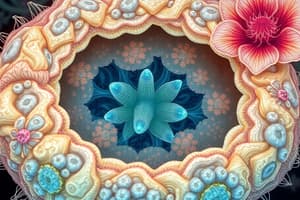Podcast
Questions and Answers
How do plants ensure genetic variation and adaptation?
How do plants ensure genetic variation and adaptation?
- Through pollinators like bees
- By undergoing mutations
- Through flowers and seeds (correct)
- By vegetative propagation
Which process involves male and female reproductive structures producing pollen and ovules?
Which process involves male and female reproductive structures producing pollen and ovules?
- Pollination
- Sexual reproduction (correct)
- Asexual reproduction
- Vegetative propagation
What is a common method of asexual reproduction in plants mentioned in the text?
What is a common method of asexual reproduction in plants mentioned in the text?
- Using wind for dispersal
- Producing spores
- Releasing pollen
- Root and stem cuttings (correct)
What is essential for research in plant ecology, agriculture, and horticulture?
What is essential for research in plant ecology, agriculture, and horticulture?
How many species have plants diversified into over time according to the text?
How many species have plants diversified into over time according to the text?
What facilitates the process of sexual reproduction in plants?
What facilitates the process of sexual reproduction in plants?
What is the main focus of cell biology?
What is the main focus of cell biology?
Which of the following is a key difference between prokaryotic and eukaryotic cells?
Which of the following is a key difference between prokaryotic and eukaryotic cells?
What is a unique feature of plant cells compared to other eukaryotic cells?
What is a unique feature of plant cells compared to other eukaryotic cells?
What is the main function of chloroplasts in plant cells?
What is the main function of chloroplasts in plant cells?
What are the main functions of plant hormones like auxins, gibberellins, and cytokinins?
What are the main functions of plant hormones like auxins, gibberellins, and cytokinins?
Which organelle is unique to plant cells and is not found in other eukaryotes?
Which organelle is unique to plant cells and is not found in other eukaryotes?
Flashcards are hidden until you start studying
Study Notes
Discovering Life's Building Blocks: Cell Biology and the Plant Kingdom
Cell biology is the study of cells, their structures, functions, and interactions, serving as the foundation for all living organisms. In this article, we'll explore how cell biology intertwines with the Plant Kingdom, a diverse group of organisms that play essential roles in our environment.
Cell Biology Basics
A cell is the smallest structural and functional unit of life. They come in two main varieties: prokaryotes (e.g., bacteria) and eukaryotes (e.g., plants, animals, and fungi). Eukaryotic cells are often larger and contain membrane-bound organelles, providing specialized functions.
Plant Cell Structure
Plant cells are unique in that they have a rigid cell wall and some additional organelles, such as chloroplasts for photosynthesis, and vacuoles for storage and turgor maintenance. Plant cells also have a distinct plastid called a plastididium, which is absent in other eukaryotes.
Plant Cell Functions
Plant cells are renowned for photosynthesis, the process by which they convert sunlight, water, and carbon dioxide into glucose and oxygen. Photosynthesis is carried out in chloroplasts, which contain the pigment chlorophyll.
Plant cells also undergo cell division and differentiation to form specialized tissues during development. The process is aided by plant hormones, such as auxins, gibberellins, and cytokinins, that regulate growth and development.
Plant Reproduction and Evolution
Plants reproduce sexually through flowers and seeds, which ensure genetic variation and adaptation. Sexual reproduction involves male and female reproductive structures that produce pollen and ovules, respectively. The process is facilitated by pollinators, such as bees, butterflies, and wind.
Plants also reproduce asexually by means of vegetative propagation, such as root and stem cuttings, to produce genetically identical offspring.
The study of plant evolution reveals that plants have undergone significant changes over millions of years, giving rise to diverse morphological forms and adaptations. Over time, plants have diversified into more than 390,000 species, forming the Plant Kingdom's vast biodiversity.
Understanding cell biology and the unique features of the Plant Kingdom is essential for research into plant ecology, agriculture, and horticulture. By appreciating the intricate workings of plant cells, students and researchers alike can better understand the complexities of life on our planet.
References:
- A Step-By-Step Guide on Writing a Biology Research Paper - BIOLOGY JUNCTION
- HOW TO WRITE A SCIENTIFIC ARTICLE - NCBI
- Reddit r/biology discussion on writing a research paper
- Reddit r/biology discussion on reading research papers
- ESA journals article on clear scientific writing (Wiley Online Library)
Studying That Suits You
Use AI to generate personalized quizzes and flashcards to suit your learning preferences.




